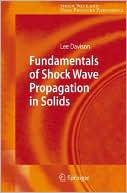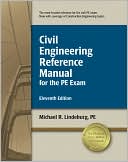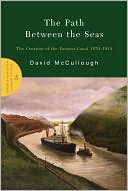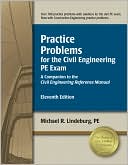Fundamentals of Shock Wave Propagation in Solids
Search in google:
This book forms an introduction to important aspects of shock-wave propagation in solid materials. Emphasis is on the regime of moderate compression that can be produced by high-velocity impact or detonation of chemical explosives. In this regime relatively simple equations of state are applicable to the description of compression. Solids may also experience inelastic flow, in which elastic-plastic deformation becomes important. The theory provided is that required to conduct research in the field and to pursue its application to ordnance development, Earth and planetary sciences, materials research, and other matters. The book includes a careful account of the kinematical and dynamical equations of the subject along with constitutive equations that describe the distinguishing responses of compressible fluids, elastic solids, and elastic-plastic and elastic-viscoplastic solids. The discussion of wave propagation begins with elementary analyses of important problems of the propagation and interaction of plane longitudinal shocks. This is followed by more refined analyses of problems of plane-wave propagation in the aforementioned materials. Finally, spall fracture, wave propagation in porous solids, and detonation phenomena are discussed. Many illustrative problems can be solved without recourse to extensive numerical analysis. The text includes numerous exercises and detailed solutions to these exercises.
Preface vIntroduction 1Mechanical Principles 7Notation 7Material Bodies, Configurations, and Motions 8Force and Stress 17Governing Equations 20Differential Equations Describing Smooth Fields 22Jump Equations Describing Plane Shocks 26Jump Equations Describing Plane Steady Waves 31Concluding Remarks on Mechanical Principles 33Exercises 34Plane Longitudinal Shocks 37Full-field Solutions 37Propagation of a Shock into Quiescent Material 38Symmetrical Plate-impact Experiment 40Hugoniot Relations 41Longitudinal Stability of Plane Shocks 46Unsymmetrical Plate-impact Experiment 48Plane-shock Interactions 51Shock Interacting with a Material Interface 51Shock Interaction with a Boundary 53Shock Interacting with Another Shock 57Exercises 60Material Response I: Principles 63General Remarks About Constitutive Equations 63Invariance Principles 65Transformation of Spatial Coordinates 65Principle of Objectivity 67Material Symmetry 68Thermodynamic Principles 71Thermoelastic Materials 73Thermoelastic Materials with Internal State Variables 76Exercises 78Material Response II: Inviscid Compressible Fluids 81Thermodynamic Properties of Fluids 82Thermodynamic Coefficients of Fluids 84Relationships Among the Thermodynamic Coefficients 84The Ideal Gas Equation of State 87Mie-Gruneisen Equation of State 92Specific Heat Coefficient for a Crystalline Solid 92Complete Mie-Gruneisen Equation of State 95Thermodynamic Response Curves 101Relationships Among Thermodynamic Response Curves 111Exercises 119Material Response III: Elastic Solids 121Objective Stress Relation 121Third-order Stress and Temperature Equations of State 122Stress and Temperature Relations for Isotropic Materials 124Separation of Dilatation and Distortion 127Finite Dilatation Combined with Small Distortion 131Exercises 134Material Response IV: Elastic-Plastic and Elastic-Viscoplastic Solids 135Elastic-Plastic Response to Small Strain 138Elastic-Plastic Response to Finite Uniaxial Deformation 148Finite Elastic-Viscoplastic Deformation 157Constitutive Equations for Viscoplastic Flow 159Constitutive Equations for Thermoelastic Response 165Uniaxial Deformation 166Exercises 168Weak Elastic Waves 169Linear Theory of Elastic Waves 169Initial-value Problem 174Boundary-value Problem 176Wave Propagation into an Undisturbed Body 179Domains of Dependence and Influence 180Characteristic Coordinates 181Plate of Finite Thickness 183Unrestrained Boundary 183Wave Interaction at a Material Interface 186Exercises 191Finite-amplitude Elastic Waves 193Nonlinear Wave Equation 193Qualitative Discussion of Elastic Wave Propagation 196Characteristic Curves 197Simple Waves 201Lagrangian Analysis 202Eulerian Analysis 209The Centered Simple Wave 216Shock Reflection from an Unrestrained Boundary 225Combined Centered Simple Waves and Shocks 229Comparison of Transitions Through Simple Waves and Weak Shocks 230Formation and Attenuation of Shocks 232Shock Formation 232Shock Attenuation 234Collision of Two Centered Simple Decompression Waves 236Exercises 245Elastic-Plastic and Elastic-Viscoplastic Waves 247Weak Elastic-Plastic Waves 247Compression Shocks 248Impact of Thick Plates 251Decompression Shocks 252Reflection from an Immovable Boundary 256Reflection From an Unrestrained Boundary 258Interaction with a Material Interface 264Impact of Plates of Finite Thickness 264Pulse Attenuation 269Numerical Solution of Weak Elastic-Plastic Wave-propagation Problems 274Finite-amplitude Elastic-Plastic Waves 275Finite-amplitude Elastic-Viscoplastic Waves 277Analysis of the Precursor Shock 277Steady Waves in Elastic-Viscoplastic Solids 283Exercises 290Porous Solids 293Materials of Very Low Density: Snowplow Model 294Strong Shocks 298Shocks of Moderate Strength: The p-[alpha] Theory 303Spall Fracture 317Experimental Means of Producing Spall Fracture 318Plate-impact Experiment 319Explosive Loading Experiment 327Pulsed-radiation Absorption Experiment 331Criteria for Spall-damage Accumulation 333Simple Damage-accumulation Criteria 333Compound Damage-accumulation Criteria 334Continuum Theory of Deformation and Damage Accumulation 336Steady Detonation Waves 343The Chapman-Jouguet (CJ) Detonation 344Strong Detonation 351Taylor Decompression Wave 352Zel'dovich-von Neumann-Doring (ZND) Detonation 358Weak Detonation 364Closing Remarks on Detonation Phenomena 364Solutions to the Exercises 367Mechanical Principles 367Plane Longitudinal Shocks 377Material Response I: Principles 385Material Response II: Inviscid Compressible Fluids 388Material Response III: Elastic Solids 394Material Response IV: Elastic-Plastic and Elastic-Viscoplastic Solids 402Weak Elastic Waves 407Nonlinear Elastic Waves 412Elastic-Plastic and Elastic-Viscoplastic Waves 418References 427Index 433








